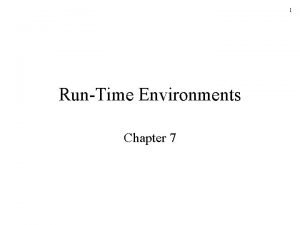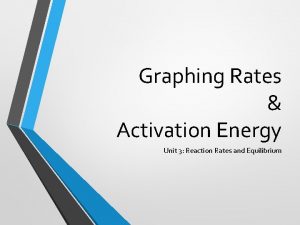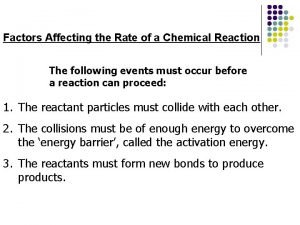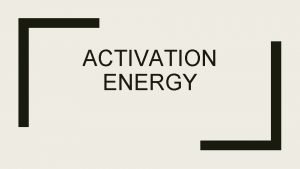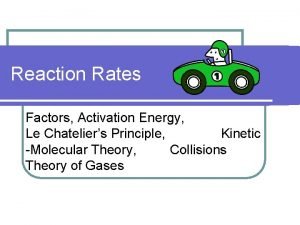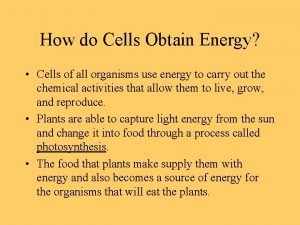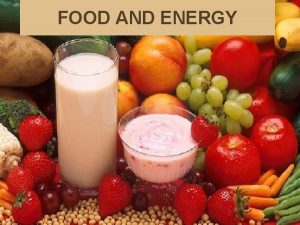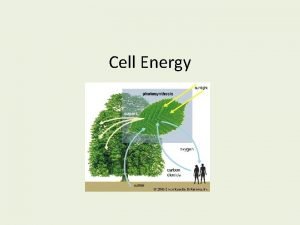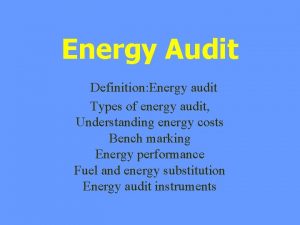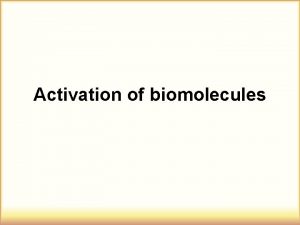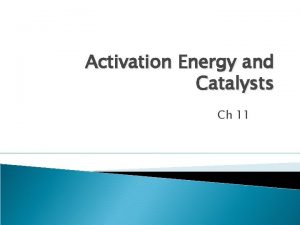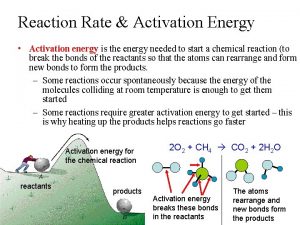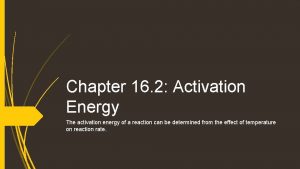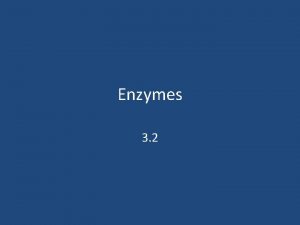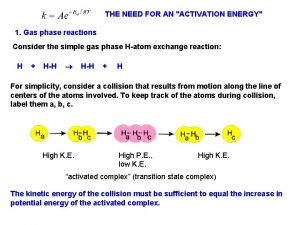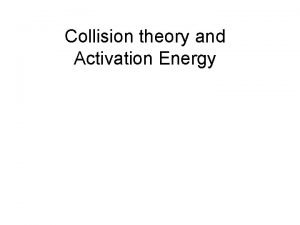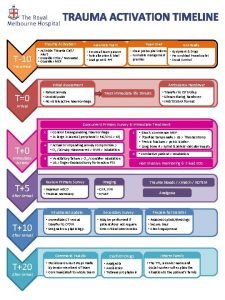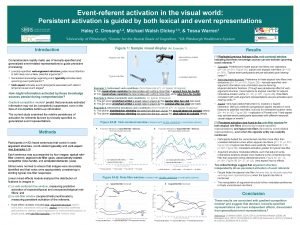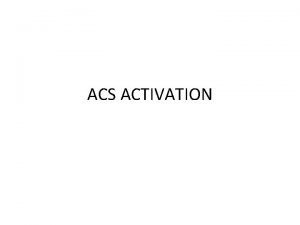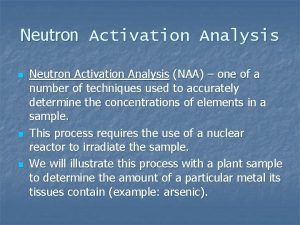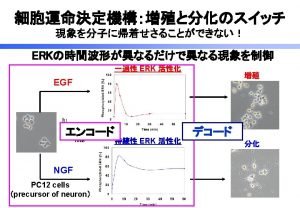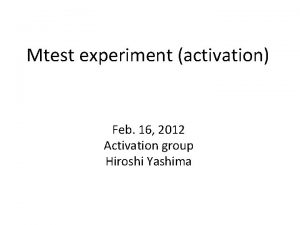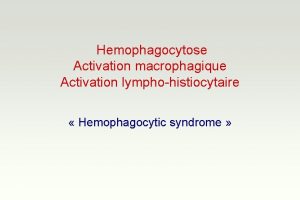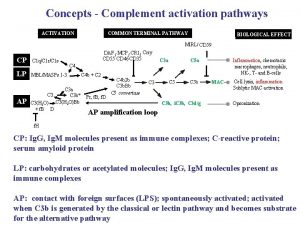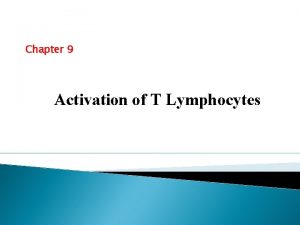THE NEED FOR AN ACTIVATION ENERGY 1 Gas





![A+B [AB]‡ products [AB]‡ = activated complex rate = [AB]‡ (rate of crossover) ( A+B [AB]‡ products [AB]‡ = activated complex rate = [AB]‡ (rate of crossover) (](https://slidetodoc.com/presentation_image_h/b2251761b83587e1c879291edc9dce6f/image-6.jpg)






![2. Enthalpy of activation, DHo‡ A+B kf kr products DHo > 0 A+B [AB]‡ 2. Enthalpy of activation, DHo‡ A+B kf kr products DHo > 0 A+B [AB]‡](https://slidetodoc.com/presentation_image_h/b2251761b83587e1c879291edc9dce6f/image-13.jpg)
![2. Entropy of activation, DSo‡ A+B kf kr products DSo >0 A+B [AB]‡ products 2. Entropy of activation, DSo‡ A+B kf kr products DSo >0 A+B [AB]‡ products](https://slidetodoc.com/presentation_image_h/b2251761b83587e1c879291edc9dce6f/image-14.jpg)









- Slides: 23

THE NEED FOR AN "ACTIVATION ENERGY" 1. Gas phase reactions Consider the simple gas phase H-atom exchange reaction: H + H-H + H For simplicity, consider a collision that results from motion along the line of centers of the atoms involved. To keep track of the atoms during collision, label them a, b, c. High K. E. High P. E. , low K. E. High K. E. “activated complex” (transition state complex) The kinetic energy of the collision must be sufficient to equal the increase in potential energy of the activated complex.

The P. E. along the reaction pathway is determined by two inter-nuclear distances, rab and rbc.

Transition state

THE REACTION ENERGY SURFACE Figure 6 -6, pg 239, E&C “transition state complex” P. E. reactants products Reaction coordinate (RC) The reaction is reduced to motion along one dimension: the “reaction coordinate”

2. Reactions in solution (the Transition State Theory; Eyring Theory) A + B products A + Solvent “cage” B A-B Products Transition state complex 1. Idea of a collision is inappropriate in solution; more like a “reactive encounter”, but the idea of a high energy intermediate at a transition state along a reaction coordinate is retained to explain the T dependence of k 2. The energy formation of the transition state complex is derived from solvent collisions with the A, B pair in a solvent cage 3. The “transition state theory” for reactions in solution focuses attention on the activated complex, and assumes that it is in effective equilibrium with the reactants with respect to all degrees of freedom except the reaction coordinate; an assumption justified, in part, by the success of theory.
![AB AB products AB activated complex rate AB rate of crossover A+B [AB]‡ products [AB]‡ = activated complex rate = [AB]‡ (rate of crossover) (](https://slidetodoc.com/presentation_image_h/b2251761b83587e1c879291edc9dce6f/image-6.jpg)
A+B [AB]‡ products [AB]‡ = activated complex rate = [AB]‡ (rate of crossover) ( ) Rate of crossover = the frequency of decomposition of AB‡ = "transmission coefficient" = fraction of [AB]‡ crossing forward 1 The frequency of decomposition of the activated complex The vibrational energy in a bond (one-dimensional harmonic oscillator) of the activated complex is Evib = k. BT = hn of vibration) n = k. BT/h (h = planck’s constant = 6. 6 x 10 -27 erg. sec; n = frequency The activated complex has an energy sufficiently great the nuclei separate during a single vibration, and the frequency of decomposition is just the vibrational frequency n

An estimate of the lifetime of the activated complex: n = k. BT/h = [1. 38 x 10 -16 erg-deg][298]/[6. 6 x 10 -27 erg-sec = 6. 2 x 1012 s-1 The lifetime = 1/n = 1. 6 x 10 -13 s ! Back to the problem of determining the rate constant rate = [AB]‡ (rate of crossover) ( ) rate = [AB]‡ (k. BT/h) Because [AB]‡ is assumed to be in thermal equilibrium with the reactants K‡ = [AB]‡ / [A] [B] [AB]‡ = K‡ [A][B] rate = (k. BT/h) K‡ [A] [B] Thus the transition state theory of the rate constant gives k = (k. BT/h) K‡

A thermodynamic description of the rate constant using the relationship between the equilibrium constant and the free energy, Where DGo‡ is the free energy of formation of the activated complex from the reactants. A+B products

This result has two important applications in Biochemistry: (1) Experimental measurements of k(T) give values for DHo‡ and DSo‡, from which a molecular model of the transition state can be deduced. (2) From a model of the transition state and corresponding information on DGo‡, DHo‡ and DSo‡ forming the activated complex, the full power of thermodynamics can be applied to analyze the effect of variables such as P, ionic strength, solvent properties, etc on the reaction rate. A change in a variable that stabilizes the transition state complex relative to reactants (reduces the magnitude of DGo‡), will increase the rate.

Comparison of the TST equation for k with the Arrhenius equation TST Arrhenius These equations to refer to the same rate constant at all temperatures, so the temperature dependence be the same. Taking A , DSo‡ and DHo‡ to be temperature independent Comparing, Substituting the first expression into the Arrhenius equation, and equating k given by the TST theory,

Experimental determination of DGo‡, DHo‡ and DSo‡ 1. DGo‡ Determined from k at any T: 2. DHo‡ and DSo‡ lnk 1/T

INTERPRETATION OF THE TST PARAMETERS IN MOLECULAR TERMS Elementary reversible chemical reaction A+B kf kr products [AB]‡ DGo<0 (Keqm > 1), DHo >0; requires DSo > 0 products 1. Free energy of activation, DGo‡
![2 Enthalpy of activation DHo AB kf kr products DHo 0 AB AB 2. Enthalpy of activation, DHo‡ A+B kf kr products DHo > 0 A+B [AB]‡](https://slidetodoc.com/presentation_image_h/b2251761b83587e1c879291edc9dce6f/image-13.jpg)
2. Enthalpy of activation, DHo‡ A+B kf kr products DHo > 0 A+B [AB]‡ products DHo‡ is generally > 0 , because covalent bonds are being broken in the transition state Formation of the complex is endothermic, and the rate increases with increasing T If DHo‡ > 0, rate increases with T
![2 Entropy of activation DSo AB kf kr products DSo 0 AB AB products 2. Entropy of activation, DSo‡ A+B kf kr products DSo >0 A+B [AB]‡ products](https://slidetodoc.com/presentation_image_h/b2251761b83587e1c879291edc9dce6f/image-14.jpg)
2. Entropy of activation, DSo‡ A+B kf kr products DSo >0 A+B [AB]‡ products In a bimolecular reaction, DSo‡ is generally negative due to the loss in entropy upon forming a single species (the activated complex) from 2 species (the reactants). In general, the more “ordered” the activated complex with respect to the reactants, the higher the DGo‡ and the lower the k

A physical change: protein folding/unfolding at 298 K where DHo 0; DSo < 0 The rate of folding is fast, and increases strongly with temperature around 298 K native ‡ ? Intermediate with Hbonds broken; increase in S unfolded

THE EFFECTS OF EXPERIMENTAL VARIABLES ON REACTION RATES: a means of exploring the transition state structure Goreactants Goproducts Any change that lowers the Go‡ relative to Goreactants (increases K‡) will increase the forward reaction rate constant 1. Ionic strength. For reactions involving ionic species, changes in ionic strength will change k 2. Pressure. If the transition state has a molecular volume different than the total volume of the reactants, pressure will change k. 3. Solvent effects. For reactions involving ionic species, changes in solvent dielectric constant will change k (see old exam)

1. Ionic reactions and the effect of ionic strength Rate constants for reactions between ionic, but not neutral, species are strongly dependent on ionic strength. Consider an elementary reaction between ionic species M and N M+N [MN]‡ → products Ionic solution are very non-ideal with respect to electrolyte concentration, so activity coefficients must be included in the equilibrium constant formation of the activated compex:

Debye-Huckel equation for the activity coefficient of ions for water at 298 K; Z = valence of i The activity coefficient decreases with increasing ionic strength due to the attractive interactions (g < 1) with counterions in solution (the ion cloud!) Changes in k due to changes in ionic strength: the principle Recall The molar free energy of an ion in solution, including the activated complex, decreases with increasing ionic strength If the activated complex decreases in free energy more than the reactants upon an increase in ionic strength, k will increase, and vice-versa.

The math Where , the rate constant at low ionic strength (at I 0, g = 1) Using the Debye-Huckel equation for logg and 1. If either ZM or ZN = 0, Z‡ 2 = (Z 2 M+Z 2 N) is the same as the charged reactant, and DGo‡ is independent of I. 2. If ZM and ZN are of opposite sign, Z‡ 2 < (Z 2 M+Z 2 N), and DGo‡ increases with increasing I (and k smaller), because the free energy of the reactants will be lowered more than the complex. 3. If ZM and ZN are of the same sign, Z‡ 2 > (Z 2 M+Z 2 N), and logic the reverse of 2.

Ionic strength dependence of k: experimental data verifying the TST prediction -

2. Pressure dependence of an enzyme reaction rate fast E + S ES‡ ES EP fast E+P The overall reaction rate will be effected by anything that changes the free energy of the activated complex ES‡ relative to the ES complex, that is, anything that changes the “equilibrium” ES ES‡ Suppose that the molecular volume of the enzyme changes in forming the activated complex such that V(ES) ≠ V(ES‡) In this case, the free energy of the activated complex will depend on pressure

(assuming is pressure independent) (a familiar equation now applied to an activated complex) DG‡ is the free energy of activation at P atmospheres. The rate constant at pressure P is then Where , the rate constant at P =1 atm

ln(k) – ln(ko) 0 A volume change in forming the activated complex can be directly measured from the pressure dependence of the rate constant P-1 For pyruvate kinase, DV‡ = +30 cm 3/mole. For reference, the molar volume of the enzyme is around 20, 000 cm 3/mole. Thus the volume change on activation is around 1%. The rate is reduced with pressure, because the volume change is positive. At the bottom of the Mariana trench (depth of 30, 000 ft), P = 1000 atm. At this pressure k/ko = 0. 27; The enzyme rate constant is reduced by about 70%. Has the enzyme for organisms that reside at the bottom evolved for a reduced volume of activation?
 Activation tree and activation record
Activation tree and activation record Activation energy unit
Activation energy unit What factors influence the rate of a chemical reaction
What factors influence the rate of a chemical reaction Reverse reaction graph
Reverse reaction graph Determine activation energy from graph
Determine activation energy from graph Activation energy
Activation energy Energy energy transfer and general energy analysis
Energy energy transfer and general energy analysis Energy energy transfer and general energy analysis
Energy energy transfer and general energy analysis Derive ideal gas equation
Derive ideal gas equation An ideal gas is an imaginary gas
An ideal gas is an imaginary gas Differences between ideal gas and real gas
Differences between ideal gas and real gas Ideal gas vs perfect gas
Ideal gas vs perfect gas Gas leaked in bhopal gas tragedy
Gas leaked in bhopal gas tragedy Gas leaked in bhopal gas tragedy
Gas leaked in bhopal gas tragedy Volume molare
Volume molare Flue gas desulfurisation gas filter
Flue gas desulfurisation gas filter Poisonous gas leaked in bhopal gas tragedy
Poisonous gas leaked in bhopal gas tragedy Difference between ideal gas and real gas
Difference between ideal gas and real gas Reaksi pembentukan gas no2f dari gas no2 dan f2
Reaksi pembentukan gas no2f dari gas no2 dan f2 Gas exchange key events in gas exchange
Gas exchange key events in gas exchange How do cells obtain energy
How do cells obtain energy Need food and energy
Need food and energy Do cells need energy
Do cells need energy Define energy audit
Define energy audit
